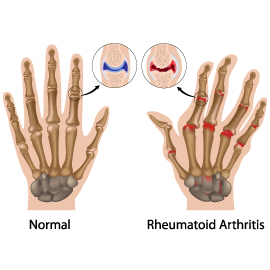Understanding Arthritis
 Arthritis is a complex disease in which one or more of your joints becomes inflamed. Arthritis is the leading cause of disability in the United States and when severe, can lead to deformity and complete loss of mobility. The condition causes a chronic pain and stiffness in the affected joints and usually becomes worse as you age. Symptoms of arthritis generally include:
Arthritis is a complex disease in which one or more of your joints becomes inflamed. Arthritis is the leading cause of disability in the United States and when severe, can lead to deformity and complete loss of mobility. The condition causes a chronic pain and stiffness in the affected joints and usually becomes worse as you age. Symptoms of arthritis generally include:
- Pain
- Stiffness
- Redness
- Swelling
- Reduced mobility and range of motion
- Warmth around the joint
- “Knots” in joints
There are many different types of arthritis, so your individual symptoms depend on the type that you have. The most common types of arthritis are: osteoarthritis and rheumatoid arthritis.
Osteoarthritis
The most common form of arthritis, osteoarthritis is a progressive degenerative joint disease. This condition is brought on by the breaking down of the cartilage surrounding your joints. Your cartilage acts as a cushion for your joints, so as this cushioning breaks down, your bones will begin to rub together. This leads to the symptoms of pain and swelling.
Osteoarthritis can affect small finger joints, the neck, the base of the thumb, ankles and the big toe. The condition usually progresses gradually and symptoms may sometimes come and go. Osteoarthritis can be caused by natural wear and tear, infection or joint injury.
Rheumatoid Arthritis
Rheumatoid arthritis is an autoimmune disease that causes your body’s immune system to attack your joints. This response in your body can cause damage to your joints as well as to important organs, like your heart, eyes, skin, lungs or blood vessels. The inflammation caused by rheumatoid arthritis occurs in joints on both sides of the body, symmetrically. The cause of this chronic disease is unknown, however possible causes could include:
- Genetics
- Environment
- Hormones
Diagnosing and Treating Arthritis
If you believe that you are suffering from a form of arthritis, Dr. Kerendian will first perform a physical exam to check your joints for swelling, redness, warmth and range of motion. You will then undergo a number of laboratory tests and possibly imaging (x-rays, MRI, CT or ultrasound) to help pinpoint the exact kind of arthritis you are suffering from.
Once diagnosed, treatment will involve easing symptoms and improving the function of your joints. Some traditional treatments may include medications, physical therapy or surgery for more severe cases. Other effective treatments may include:
- Myofascial Release
- Osteopathic Manipulative Treatment
- Trigger Point Injections
- Prolotherapy
Arthritis can be painful and debilitating. If left untreated it can lead to deformities or become disabling. In serious cases surgical intervention may be required although there are a variety of options available that may reduce pain, restore mobility and prevent further joint damage. If you believe you are suffering from arthritis, it is important to begin treatment so that you can manage your pain and live comfortably.


